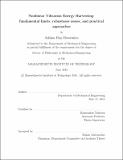| dc.contributor.advisor | Konstantin Turitsyn. | en_US |
| dc.contributor.author | Haji Hosseinloo, Ashkan | en_US |
| dc.contributor.other | Massachusetts Institute of Technology. Department of Mechanical Engineering. | en_US |
| dc.date.accessioned | 2018-11-28T15:25:39Z | |
| dc.date.available | 2018-11-28T15:25:39Z | |
| dc.date.copyright | 2018 | en_US |
| dc.date.issued | 2018 | en_US |
| dc.identifier.uri | http://hdl.handle.net/1721.1/119277 | |
| dc.description | Thesis: Ph. D., Massachusetts Institute of Technology, Department of Mechanical Engineering, 2018. | en_US |
| dc.description | This electronic version was submitted by the student author. The certified thesis is available in the Institute Archives and Special Collections. | en_US |
| dc.description | Cataloged from student-submitted PDF version of thesis. | en_US |
| dc.description | Includes bibliographical references (pages 119-130). | en_US |
| dc.description.abstract | The problem of a scalable energy supply is one of the biggest issues in miniaturizing electronic devices. Advances in technology have reduced the power consumption of electronic devices such as wireless sensors, data transmitters, and medical implants to the point where harvesting ambient vibration, a universal and widely available source of energy, has become a viable alternative to costly and bulky traditional batteries. However, implementation of vibratory energy harvesters is currently impeded by three main challenges: broadband harvesting, low-frequency harvesting at small (micro) scales, and robust energy harvesting at presence of parametric uncertainties. This thesis investigates two main directions for effective vibration energy harvesting: (i) fundamental limits to nonlinear energy harvesting and techniques to approach them, and (ii) robust energy harvesting under uncertainties. As well as being of fundamental scientific interest, understanding maximal power limits is essential for assessment of the technology potential and it also provides a broader perspective on the current harvesting mechanisms and guidance in their improvement. We begin by developing a general framework and model hierarchy for the derivation of fundamental limits of the nonlinear energy harvesting rate based on Euler-Lagrangian variational approach. The framework allows for an easy incorporation of almost any constraints and arbitrary forcing statistics and represents the maximal harvesting rate as a solution of either a set of DAEs or a standard nonlinear optimization problem. Closed-form expressions are derived for two cases of damping-dominated and displacement-constrained motion. Stemming from the study of fundamental limits, we present an almost-universal strategy termed buy-low-sell-high (BLSH) to maximize the harvested energy for a wide range of set-ups and excitation statistics. We further propose two techniques to realize the non-resonant BLSH strategy, namely latch-assisted harvester and adaptive bistable harvester. To validate the efficacy of the proposed strategy and practical techniques, we perform a simulation experiment by exposing the said harvesters to harmonic and experimental, random walking-motion excitations; it is shown that they outperform their linear and conventional bistable counterparts in a wide range of harmonic excitation and random vibration. Furthermore, we propose to harvest energy by exploiting surface instability or in general instability in layered composites which is, in part, motivated by the BLSH strategy. Instabilities in soft matter and composite structures e.g. wrinkling allow large local strains to take place throughout the entire structure and at regular patterns. Unlike conventional harvesting techniques, this allows to harvest energy from the entire volume of the structure e.g. by attaching piezoelectric patches at large-strain locations throughout the structure. We show that this significantly improves the power to volume ratios of the harvesting devices. In addition, these structural instabilities are non-resonant that consequently enhances robustness of such harvesters with respect to excitation characteristics. The high efficacy of energy harvesting via structural instabilities, in part, is attributed to its ability to approximately follow the BLSH logic. Additionally, we put forth the idea of extending this idea to control the instability; and hence, extend the application of the aforementioned idea from energy harvesting to a whole new level of tunable material/structures with a myriad of applications from electromechanical sensors and amplifiers to fast-motion actuators in soft robotics. And last but not least, to more specifically address the robustness issues of passive harvesters, we propose a new modeling philosophy for optimization under uncertainty; optimization for the worst-case scenario (minimum power) rather than for the ensemble expectation of the power. The proposed optimization philosophy is practically very useful when there is a minimum requirement on the harvested power. We formulate the problems of uncertainty propagation and optimization under uncertainty in a generic and architecture-independent fashion. Furthermore, to resolve the ubiquitous problem of coexisting attractors in nonlinear energy harvesters, we propose a novel robust and adaptive sliding mode controller for active harvesters to move the harvester to any desired attractor by a short entrainment on the desired attractor. The proposed controller is robust to disturbances and unmodeled dynamics and adaptive to the system parameters. | en_US |
| dc.description.statementofresponsibility | by Ashkan Haji Hosseinloo. | en_US |
| dc.format.extent | 130 pages | en_US |
| dc.language.iso | eng | en_US |
| dc.publisher | Massachusetts Institute of Technology | en_US |
| dc.rights | MIT theses are protected by copyright. They may be viewed, downloaded, or printed from this source but further reproduction or distribution in any format is prohibited without written permission. | en_US |
| dc.rights.uri | http://dspace.mit.edu/handle/1721.1/7582 | en_US |
| dc.subject | Mechanical Engineering. | en_US |
| dc.title | Nonlinear vibration energy harvesting : fundamental limits, robustness issues, and practical approaches | en_US |
| dc.type | Thesis | en_US |
| dc.description.degree | Ph. D. | en_US |
| dc.contributor.department | Massachusetts Institute of Technology. Department of Mechanical Engineering | |
| dc.identifier.oclc | 1065537462 | en_US |

